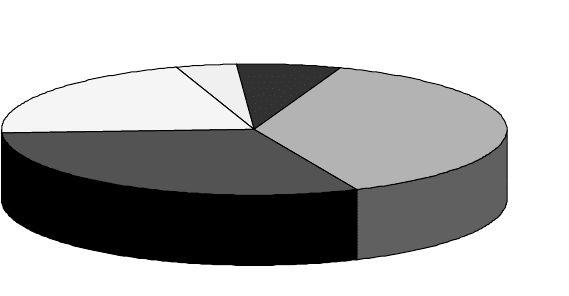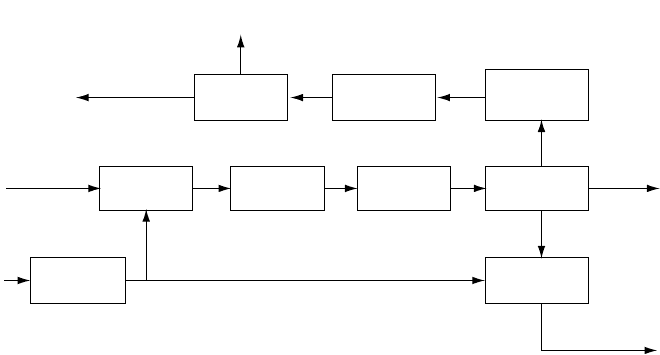Higman Chris Gasification (Газификация угля)
Подождите немного. Документ загружается.


340
Gasification
emerged to counter the problem despite the intensive debate over the last 10 or 15
years. Nonetheless, there is no disputing the correlations between global average
temperatures and atmospheric CO
2
concentrations (as determined from Antarctic ice
cores) over hundreds of thousands of years, and between anthropogenic emissions
and atmospheric CO
2
concentrations over the last 250 years (Figures 9-5A and 9-5B).
And whether we understand the mechanisms in detail or not, it is certainly wise to
take measures to reduce man-made contributions to global warming.
Before discussing what place gasification could have in any such strategy for CO
2
emissions reduction, it may be useful to have a look at the overall greenhouse gas
effect as related to the use of fossil fuels.
As can be seen from Figure 9-6, the two biggest contributors to CO
2
emissions
are the electric power and transport sectors. Given the millions of small moving
emission sources involved in transport, any significant reductions in CO
2
emissions
is only likely to emerge through the change to a less carbon-intensive fuel such as
natural gas or hydrogen. Although the use of natural gas (at least while it lasts)
would still result in large, even if lower, emissions from millions of individual
sources, the use of hydrogen offers the possibility of bundling CO
2
emissions at fixed
locations in a manner that would allow fixation or sequestration. Further discussion
of this aspect is discussed after first looking at the largest CO
2
emitter, the power sector.
A major contribution to lowering CO
2
emissions in the power industry could be
realized almost immediately simply by increasing the efficiency of the power park.
Replacement of a 30-year-old coal-fired unit operating at, for example, 32%
efficiency by a modern plant (whether with IGCC or ultra-supercritical PC technology)
using the same fuel with an efficiency of 43% would drop the CO
2
emissions per
produced kilowatt-hour by 25%. The barriers here are not of a technological but of
a financial nature given the limited capital and incentive for such replacement
projects. Again, the reductions offered by cogeneration (or combined heat and power),
although ultimately limited by the available heat sinks, face at present financial
rather than technical hurdles.
1000
7000
6000
5000
4000
3000
2000
ATMOSPHERIC CONCENTRATIONS
ANTHROPOGENIC EMISSIONS
200019501900185018001750
380
360
340
320
300
280
260
150
350
300
200
250
THOUSANDS OF YEARS AGO
050100
ATMOSPHERIC CONCENTRATIONS
TEMPERATURE CHANGE
–6
+4
+2
0
–2
–4
TEMPERATURE CHANGE [°C]
CO
2
CONCENTRATIONS [PPMV]
CO
2
CONCENTRATIONS [PPMV]
CO
2
EMISSIONS [MILLION TONS CARBON]
(A) (B)
Figure 9-5.
Figure 9-5.Figure 9-5.
Figure 9-5. (A) Correlation Atmospheric CO
2
Concentration and Temperature
(Source: Simbeck 2002); (B) Correlation between Anthropogenic CO
2
Emissions
and Atmospheric CO
2
Concentrations (Source: U.S. Oak Ridge National
Laboratory)

Economics, Environmental, and Safety Issues
341
Beyond the above, serious consideration is now being given to recovery of the
CO
2
from the energy conversion process and putting it to use or simply sequestering
it. In such a scenario there are some natural advantages to gasification over combus-
tion technologies. In fact, CO
2
capture and usage is already standard practice in
almost all gasification-based ammonia plants, where the CO
2
is recovered from the
synthesis gas and used to manufacture urea.
Another example of CO
2
recovery from a coal gasification plant is the Great
Plains SNG plant, which sells CO
2
for enhanced oil recovery (EOR) in the Weyburn
field in Canada. EOR is particularly attractive for CO
2
usage in that besides the
avoidance of adding to atmospheric CO
2
, it provides a means of extending the life of
existing energy resources. EOR has been practiced in the Permian basin oil fields in
Texas for over 30 years, although much of the CO
2
used comes from natural under-
ground CO
2
reservoirs and therefore does not as such contribute to greenhouse gas
abatement. Nonetheless, it points the way to one potential route for sequestration.
Other alternatives have been or are being investigated as well, such as sequestration
in underground saline aquifers (e.g., Statoil’s Sleipner project in the North Sea),
storage in coal seams, and others (White 2002; Beecy 2002).
As mentioned above, gasification-based processes have a natural advantage over
combustion technologies when it comes to CO
2
capture. In one study based on using
gasification with total water quench technology at 80 bar, the addition of CO
2
capture was shown to add only a small increment on capital costs (about 5%) and an
efficiency penalty of only 2% (O’Keefe and Sturm 2002). The block flow scheme is
shown in Figure 9-7.
This should be compared with the impact of CO
2
capture on a ultra supercritical
PC combustion technology power block. This is extremely heavy even if one
assumes the prior existence of FGD and SCR flue gas treatment, which are a prereq-
uisite for CO
2
recovery from the flue gas, for which at present amine scrubbing is
Commercial
4%
Industrial
21%
Residential
7%
Transport
31%
Electric utilities
37%
Figure 9-6.
Figure 9-6.Figure 9-6.
Figure 9-6. Share of U.S. CO
2
Emissions by Sector (Source: U.S. EPA 2002)

342
Gasification
universally proposed. The key fact is that the volume of gas from which the CO
2
has
to be extracted is in the case of combustion technology 150–200 times larger than is
the case in an IGCC plant. The add-on capital cost has variously been estimated at
60–80%. The steam requirement for amine regeneration is lost to the final turbine
stages, and this causes a drop in efficiency of some 9.5–14 percentage points
(Simbeck 2002; Koss and Meyer 2002).
Clearly there is an incentive to find some use for the CO
2
and “recycle” it. Although
there may be local markets where this is possible on a small scale, a review of the
data in Table 9-5 will show that the “chemical” scope for such a solution on a global
scale is very limited. Apart from oxygen and hydrogen, there are no potential reactants
with relative mass flows approaching that of carbon. Even iron usage is an order of
magnitude smaller. It is further observed that the only mass in the world that is of
the same order of magnitude as fossil fuels is waste biomass flow (though this is not
valid for the energy, which is an order of magnitude less) (Shell 2002).
The only major application of waste CO
2
is for the enhanced recovery of oil and
gas, but most of the CO
2
will have to be sequestered underground in depleted gas
fields, in aquifers, and in deep-sea basins (van der Burgt, Cantle, and Boutkan
1992).
An alternative option for removing CO
2
from flue gases from power stations that
has been proposed is combustion with pure oxygen. The flue gas will then contain
only water and CO
2
, and in the case of coal and heavy oil fractions, also SO
2
, NO
x
,
and other contaminants such as mercury. The advantage is that in this case all
contaminants can be sequestered together, and apart from the ASU, no gas separations
are required. However, with the present cryogenic separation of air, this solution is
unlikely become attractive for both economic and efficiency reasons. Moreover, in
ASU
CLAUS
GASIFIER
SATURATOR
EXPANDER
SULFUR
FEED
OXYGEN
AIR
CO
2
LEAN
FLUE GAS
ELECTRIC
POWER
COMBINED
CYCLE UNIT
SELECTIVE
AGR
RAW GAS
CO SHIFT
WATER
QUENCH
H
2
S
CO
2
Figure 9-7.
Figure 9-7.Figure 9-7.
Figure 9-7. IGCC with CO
2
Capture

Economics, Environmental, and Safety Issues
343
the case of CC power stations, this route would require the development of gas turbines
that is optimized to handle pure tri-atomic gases.
It should be noted that the IGCC variant provides a source of hydrogen that, with
a combination of membrane and PSA technologies, can be extracted during periods
of low electric power demand and stored for onward sale into the transport sector.
The importance of this possibility is discussed further in Chapter 10.
Methane. On a mole for mole basis, methane contributes 20 to 25 times more to the
greenhouse effect than CO
2
. Anthropogenic methane from fossil sources enters the
atmosphere in the form of vented or incompletely combusted associated gas, leaks
in natural gas pipelines, and methane emissions related to coal mining.
The largest source of methane emissions resulting from fossil fuel production
and refining derives from the associated gas. On average about 10% of the energy
leaving an oil well is in the form of associated gas, and assuming that 5% of this gas
is not combusted either because people do not want to see flares or because flares
are not working properly, it is conservatively estimated that about 8% of the green-
house gas effect related to the use of crude oil is due to methane emissions during
production. Adding to this the effect of the CO
2
from the 95% of the associated gas
that is properly combusted in operating flares, this figure increases to 15%. Schaub
and Unruh (2002) have estimated that the quantity of associated gas flared in
Nigeria alone would be sufficient to supply 30% of Germany’s natural gas supply.
Clearly, there is potential here for a reduction in greenhouse gas emissions, to which
synfuels production via partial oxidation of the gas and subsequent Fischer-Tropsch
synthesis could make a significant contribution. Global application of such a solution
Table 9-5
Important Mass Flows in the World
Ton/y Relative Mass
Flow
Fossil fuels 10 ×10
9
100
Carbon 8 ×10
9
80
CO
2
emissions 30 ×10
9
300
Chemicals 3 ×10
8
3
Ceramic building materials 10−15 ×10
8
10–15
Iron 5 ×10
8
5
Carbon for iron ore reduction 3 × 10
8
3
Carbon for SiO
2
reduction, 100,000 MW
e
peak/year new installed (1 mm thick wafers) 1 ×10
6
0.01
Waste biomass 5–10 × 10
9
50–100
Source: Shell 2002

344
Gasification
could reduce the 15% of the greenhouse gas effect related to the use of crude oil to
a mere 2–3%.
9.2.3 Liquid Effluents
Whether a gasification complex is a net water consumer or producer will depend on
the feedstock and the downstream operation. In general, when coal or petroleum
residues are used as feedstock, there is always a net consumption of water, whereas
with natural gas–based plants, there can be a net production of water. Similarly, the
application, chemicals or power, will have an influence over the overall water
balance of the plant.
Most gasification plants have a water wash at some part of the syngas treatment.
For coal gasifiers, its main purpose is to remove ammonia and chlorides, though
many other constituents of the gas are also captured. Whether this process water is
acidic or basic will depend on the amounts of nitrogen and chlorine in the coal.
Whatever the pH of this water, it will almost certainly require to be adjusted during
the flocculation step of the overall water treatment. In oil gasification plants, the
main objective is removal of soot, but the water also contains ammonia, hydrogen
cyanide, and H
2
S.
In practice, with appropriate design, an IGCC can be made with zero liquid
discharge, whether using a dry feed technology as in Buggenum (Coste, Rovel, and
George 1993) or a slurry feed as in Polk (U.S. Department of Energy 2000). In both
these plants the final water treatment stage is a brine concentration and evaporation
unit producing a solid waste salt.
Oil gasification units generally do not recycle the excess process water. In those
applications, where the plant is located in a refinery, the water treatment is generally
integrated into that of the overall refinery after ammonia, HCN, and H
2
S have been
removed in a sour water stripper. Typical emission limits and performance for
a stand-alone plant are given in Table 9-6
Specific aspects of water treatment are addressed in the following sections.
Table 9-6
Emission Limits and Oil-Based IGCC Performance
Pollutant Emission Limits Oil-IGCC Regulation
Vanadium (mg/l) 2 <2 City of Hamburg
Nickel (mg/l) 0.5 <0.5 Rahmen Abwasser
VwV 1992
BOD
5
(mg/l) 25 <20 Rahmen Abwasser
VwV 1992
Economics, Environmental, and Safety Issues
345
Fluorine. Fluorine in the gas will dissolve in the wastewater from the water wash,
from which it can be removed by adding calcium ions that will precipitate the fluorine
as CaF
2
. This salt will eventually end up in the same settler/filter cake as the heavy
metal-containing precipitate from the flocculation unit.
Cyanide and Cyanometallates. A significant portion of the HCN produced in the
gasifier is contained in process condensate. In any plant gasifying heavy oil, the
excess water from the gasification section is usually stripped to remove free ammonia,
H
2
S, and HCN. Typically, residual HCN values of 10–20 mg/l can be achieved in
a single-stage stripper. The residual HCN can be reduced to below 1 ppm in a
biological treatment unit.
An alternative approach to cyanide and cyanometallates is to oxidize them. This
is particularly appropriate when recycling all the process condensate for a zero-
discharge system. Although aeration in a closed vessel is possible and has been
employed, the required contact times are long and require large volumes. A more
economic approach is the use of ozone as an oxidant, since this reacts rapidly with
the cyanides (Coste, Rovel, and George 1993).
Heavy Metals Precipitation. Whether gasifying coal or heavy residues, there are heavy
metals contained in the process condensate. Typically, these are subjected to treatment
by flocculation and precipitation. The choice of flocking agent is determined by the
metals to be removed, but is typically ferric chloride. The metals sludge from the
precipitation stage is then thickened prior to filtration.
The excess water so treated would be “free of fluorides, cyanides and heavy
metals and contain only dissolved soluble salts” (Coste, Rovel and George 1993).
Sand filtration may be required to remove traces of metal hydroxides from the
flocking step.
9.2.4 Solid Effluents
Solid effluents from gasification plants are essentially related to the ash in the feed-
stock, the quantities of which can vary from as much as 40 wt% in some coals to under
1 wt% for petroleum feeds. In many cases gasification plants are able to make the solid
residue available in a form that can be used as a raw material in other industries.
In contrast to a PC boiler, gasification has no FGD sludge or gypsum disposal
problem because the sulfur is all captured as elemental sulfur in the Claus plant. At
present this is a saleable product, although one should be aware that, were a large
part of the power industry to switch to gasification-based processes, this together
with increasing sulfur production from oil refineries would oversaturate the market.
Nonetheless, even in this case the amounts of material would be substantially
smaller than with gypsum.

346
Gasification
Dry Coal Ash. Dry ash from nonslagging gasifiers is essentially the same material
as the product of a PC boiler processing the same feed. This ash can often be utilized
in the cement or building industry. If this option is not available due to the nature of
the ash or due to transport problems, the ash can become a major environmental
liability that can be aggravated if the ash is leachable or caustic in nature. The ash is
then often stored in large ponds, which have become more and more unacceptable.
This problem can be largely avoided by selecting a slagging gasifier from which the
quantity of dry ash waste is one to two orders of magnitude lower than from a dry
ash gasifier.
Slag. Slagging gasifiers have in general an advantage over dry ash processes in that
most of the ash components leave the gasifier as molten slag, which on being
quenched turns into a fine inert gritty material that can be used as a replacement for
sand and aggregate in concrete, for example. Van Liere, Bakker, and Bolt (1993)
give the particle size of water-quenched slag as being about 78–80% in the range
0.5–4 mm in a paper in which they describe usage trials in Dutch road construction.
Data from Geertsema, Groppo, and Price (2002) generally supports this size data
for the actual slag component, although the material analyzed contained consider-
able quantities of unreacted carbon, which after separation are recycled to the gasi-
fier or used as fuel in a PC boiler. They report the slag as being used for blasting
grit and roofing granules. Amik and Dowd (2001) provide an analysis for slag
produced at the Wabash River plant (Table 9-7), which essentially mirrors the ash
content of the coal used. The slag contains trace metals such as lead, arsenic,
selenium, chrome, antimony, zinc, vanadium, and nickel, which is captured in the
nonleachable glassy matrix. The results of some leachability tests are included in
the paper. They report marketing for asphalt, construction backfill, and landfill
cover applications.
Table 9-7
Slag Analysis
SiO
2
51.8 %
Al
2
O
3
18.7%
TiO
2
0.9%
Fe
2
O
3
20.3%
CaO 4.2%
MgO 0.8%
Na
2
O 1.0%
K
2
O 1.9%
Source: Amik and Dowd 2001
Economics, Environmental, and Safety Issues
347
Heavy Metals. The nature of any heavy metals leaving the plant as solid effluent
will depend heavily on the feedstock. With a coal feed, most heavy metals will end
up in the slag or fly ash of a gasifier. Heavy metals that are not removed together
with the fly ash and slag will eventually end up in the wastewater from the water wash.
As described on page 345 the heavy metals are removed from the water as a filter
cake after treatment by flocculation and precipitation. With coal feeds this filter
cake may contain such elements as arsenic, antimony or selenium. Unlike the slag,
this concentrate is not inert and has to be considered as chemical waste.
In the case of oil feeds, the main heavy metals are vanadium, nickel, and iron.
There are a number of processes available for recovering the ash for use in the
metallurgical industry (see Section 5.4). The economics of such processes depends
very much on the vanadium content in the ash.
Salt. All coal gasifiers will have dissolved salts in the treated wastewater. When this
water cannot be disposed of, the water has to be evaporated and a salt mix is
obtained that consists of over 98% NaCl. This product is often not suitable as road
salt and may have to be considered as chemical waste.
9.2.5 Waste Gasification
For reasons that are mostly historical, emissions regulations for thermal treatment of
waste are generally much more stringent than for, say, a coal-based power plant.
Waste gasification plants, particularly slagging units, have the potential to provide
a viable alternative to incineration. The current review in the United States on
removing refinery wastes that are processed to syngas from the hazardous classification
is, however, typical of the moving targets in this field. A number of plants, such as
Schwarze Pumpe, provide a local or regional waste disposal center in which waste is
gasified and the syngas used for production of methanol and electricity. Here the solid
slag is nonleachable and meets the German municipal waste standards “Siedlungsabfall
class 1” (Greil et al. 2002).
9.3 SAFETY
Issues of safety are associated with practically all industrial technologies, and under-
standing the appropriate measures for safety management is an important part of
understanding the technology itself. In this respect, gasification is no different from
many other technologies. The purpose of this section is to make those unfamiliar
with gasification aware of those issues that may be considered specific to the tech-
nology. It is certainly no substitute for a project-specific safety manual and does not
address issues common to any large-scale industrial plant. It does, however, point to
other sources, which may help the reader develop his or her own ideas for a particular
project in more detail.
348
Gasification
Gasification plants are complex plants that produce a high-pressure toxic gas that
is inflammable or even explosive in the presence of oxygen and an ignition source.
Furthermore, the presence of pure oxygen, as is the case in most gasification pro-
cesses, requires additional precautions. Generally, all these dangers are well taken
care of in the process designs. Handled correctly during construction, operation, and
maintenance, they pose no more problems to personnel or environment than many
other industrial plants.
9.3.1 Start-Up
One of the potentially dangerous moments during start-up is the ignition of the coal
or oil burners. The problem is much more complex than in regular atmospheric
pressure furnaces, as ultimately the burners have to work at pressures ranging from
20–70 bar, and there are no burners that can operate properly over this whole pressure
range. Where membrane walls are used, which cool very quickly in the absence of
a flame, start-up burners often have to be used to cover part of this pressure range.
At all times the situation should be avoided in which a mixture of a combustible gas
and oxygen is present in the reactor.
9.3.2 Shutdown
After shutdown the gasifier is often nitrogen blanketed to avoid corrosion. When
repairs have to be carried out inside the gasifier, one has to make sure that there are
no other gases than air present. Drawing a good vacuum and breaking this with air is
the best way to ensure that only air is present. This operation may have to be
repeated several times to ensure that all noxious gases are removed from insulating
materials, bricks, and dead ends in the plant. Even with all these precautions, air
masks may be required under certain conditions.
9.3.3 Spontaneous Combustion
As in a conventional PC power plant, safety precautions in coal storage and hand-
ling are essential to avoid spontaneous combustion. This applies equally well to
other feedstocks such as biomass and certain types of waste. The key in particular is
to prevent fines from drying out, so that a first-in first-out inventory policy must be
part of the safety procedures.
Besides the fuel itself, there are other potential sources of spontaneous combustion.
Particular attention must be paid to FeS which may form as a product of corrosion.
Another potential source is incorrect handling of catalysts, particularly unloading spent
catalyst, which may not have been adequately oxidized in situ. Acting in strict
conformity with the catalyst vendors' procedures is important.
Economics, Environmental, and Safety Issues
349
9.3.4 Toxic and Asphyxiating Materials
Apart from the main syngas component, carbon monoxide, there are many other toxic
gases present in a gasification complex, particularly if the end product is a chemical.
Typical toxic gases present in synthesis gas can include compounds such as H
2
S and
COS as well as ammonia and HCN. The design of a plant must take account of this,
and personnel must be trained in their safe handling. There are many public sources of
safety information available on material safety data sheets. Many of these are
available from Internet sources such as www.ilpi.com/msds, which has links to many
international source sites. An up-to-date data sheet should always be available with
the safety officer or other member of staff responsible for safety training.
Nitrogen. It may come as a surprise, but a large part of the accidents occurring in
gasification plants are due to nitrogen that is produced as a (by-)product from oxygen
plants and used for blanketing and transport of coal and further as a diluent for the
fuel gas. In this latter function it reduces the stoichiometric adiabatic flame temperature
and as a result the thermal NO
x
.
The problem with nitrogen is that contrary to the fuel gas it has no smell, and
even more problematic, it leads very fast to unconsciousness. Good ventilation of
the plant is a very efficient precaution. Building a gasifier inside a closed structure
because it may look better from a distance can be dangerous. Not only because of
nitrogen, but also because we deal with pressurized gases containing CO, H
2
S, COS,
HCN, and NH
3
. If the plant has to be visually enclosed, the best alternative is to
have louver walls that guarantee good ventilation.
CO
2
. Where concentrated CO
2
streams are present, one should be aware of its
asphyxiating properties and the fact that it is heavier than air. The potential danger is
not only because of leaks and open valves. Also, the gas in the stacks through which
the CO
2
is vented should have sufficient buoyancy by ensuring elevated tempera-
tures. For all large quantities, dispersion calculations should be made.
9.3.5 Oxygen
Oxygen makes up about 21% of our atmosphere and is essential to life. It is also an
essential ingredient for combustion in which fuels are oxidized in an extremely
exothermic reaction. If oxygen is present in concentrations significantly above 21%,
then the combustion becomes much more vigorous, and materials such as metals
that normally oxidize in a slow manner without fire risk (e.g., rusting of iron) can
behave as fuels for fire. When handling oxygen it is therefore essential to take the
necessary precautions to prevent oxygen fires.
The precautions necessary for safe operation of oxygen systems are well codified.
Not only do all the leading industrial gas supply companies and gasification techno-
